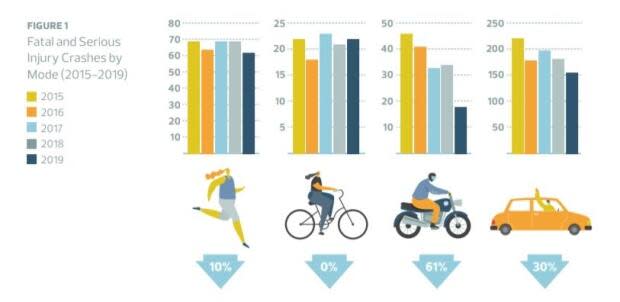Collisions down in COVID-19 but traffic deaths nearly same as 2019
Collisions on Edmonton streets have dropped during the COVID-19 pandemic, but the city says nearly the same number of people died in traffic-related incidents so far this year as in 2019.
Jessica Lemarre, the City of Edmonton's director of traffic safety, said the volume of traffic decreased at different points in the past eight months and likewise, so did collisions.
However, 12 people have died in traffic collisions so far this year, while 14 people died in 2019.
"Which tells us things like speed and impairment continue to be extremely risky behaviour — not only risky, but also illegal — that leads to tragedy," Lemarre said.
At a news conference Thursday, Lemarre presented an outline of Safe Mobility Strategy 2021-2025, a new approach by the city to achieve Vision Zero.
The city adopted Vision Zero in 2015, a campaign that started in Sweden in 1997 with the long-term goal of zero traffic-related fatalities and serious injuries.
In 2015, 32 people died from traffic collisions on Edmonton roads.
By 2019, that death toll had been cut in half, Lemarre said, and there were 30 per cent fewer serious injuries than five years earlier.
Lemarre noted that 69 per cent of serious collisions and deaths are on arterial roads.
"We know when we look at the cause of those crashes that 80 per cent of those crashes are the results of driver error."
Since Vision Zero began in Edmonton, 82 crosswalks have been upgraded, the report says.
Pedestrian vs driver
Safety measures, such as improving signals and signs at intersections, have proven effective for drivers but not so much for pedestrians and cyclists.
The report shows from 2015 to 2019, motorcycle crashes were down about 60 per cent and vehicle crashes, 30 per cent.
Crashes involving people walking were down 10 per cent, and those with cyclists didn't change.

The city uses data from Edmonton police reports to dissect causes and elements related to collisions.
In 2019, the top causes of serious and fatal collisions were tailgating, drivers losing control and running off the road, not yielding to a pedestrian, drivers running red lights, and turning left across the path of another vehicle or person.
In the coming months, Lemarre said the city will continue exploring traffic-calming measures and safety improvements.
She said there are many options, including community-focused projects like jersey barriers painted by local artists or vibrant crosswalks with creative paint.
In recent years, the city has installed eight scramble crosswalks and synchronized signals, she noted.
Council's urban planning committee will review the strategy at a meeting next Tuesday.
Like previous traffic safety work, the new strategy will be funded by the automated enforcement reserve. Proposed budgets for new traffic safety work will be presented to city council early next year.
Photo radar
Part of the Safe Mobility Strategy includes photo radar, a controversial area of speed enforcement that Coun. Andrew Knack hopes can be partly resolved.
"There's this never-ending debate on whether photo radar is a cash cow," Knack said.
More than a year ago, Knack asked city administration for an update on an interactive map they were working on that would show people if photo radar improved safety at various locations it's used around Edmonton.
"Instead of that immediate reaction of either it's good or it's bad, actually have some hard data to be able to show people and say: 'in each location, here's the specific impact we have seen when we use this tool'."
Knack said in the west end, the stretch on 142nd Street between 107th Avenue and Stony Plain Road gets a lot of criticism.
The speed limit goes down to 50 km/h from 60 km/h.
"I'm not sure if that's making things better," Knack said. "Is there a better set of tools?"
Lemarre said that data and the interactive map - to be posted on the City's Open Data site — is scheduled to be complete by the end of the year.

